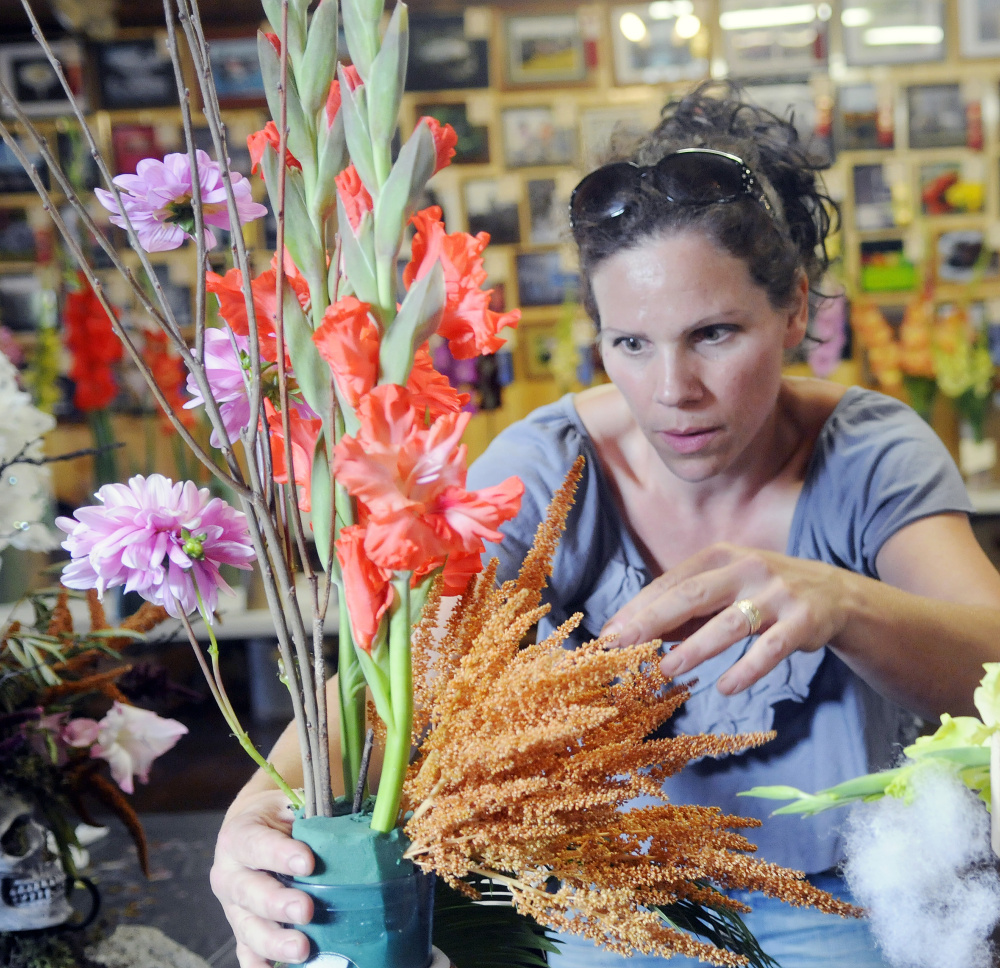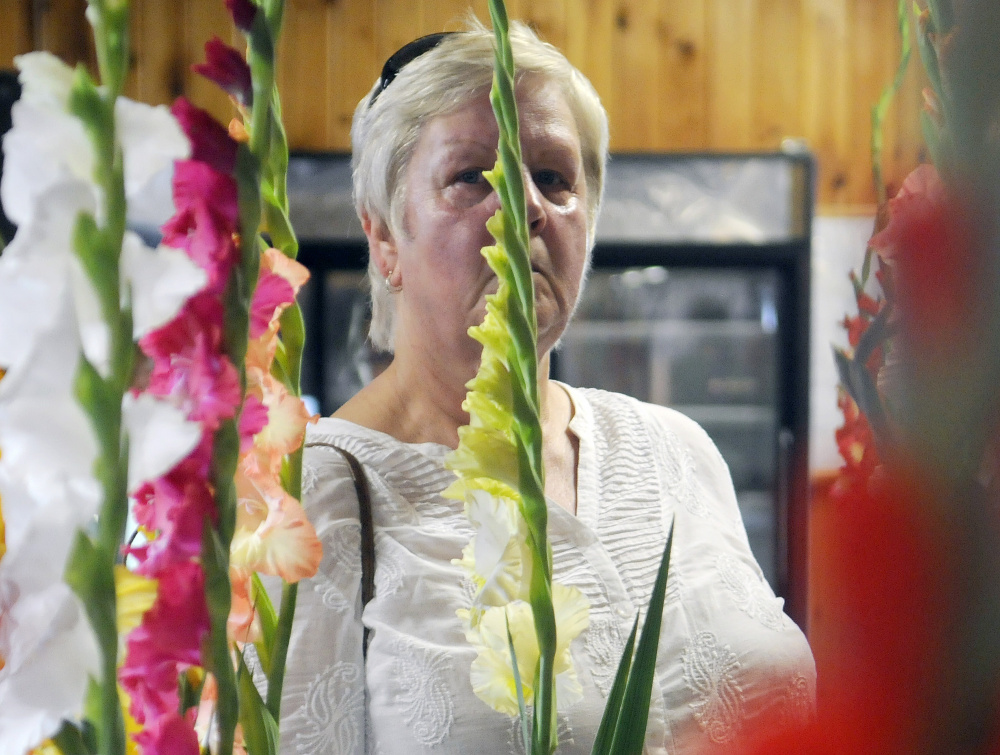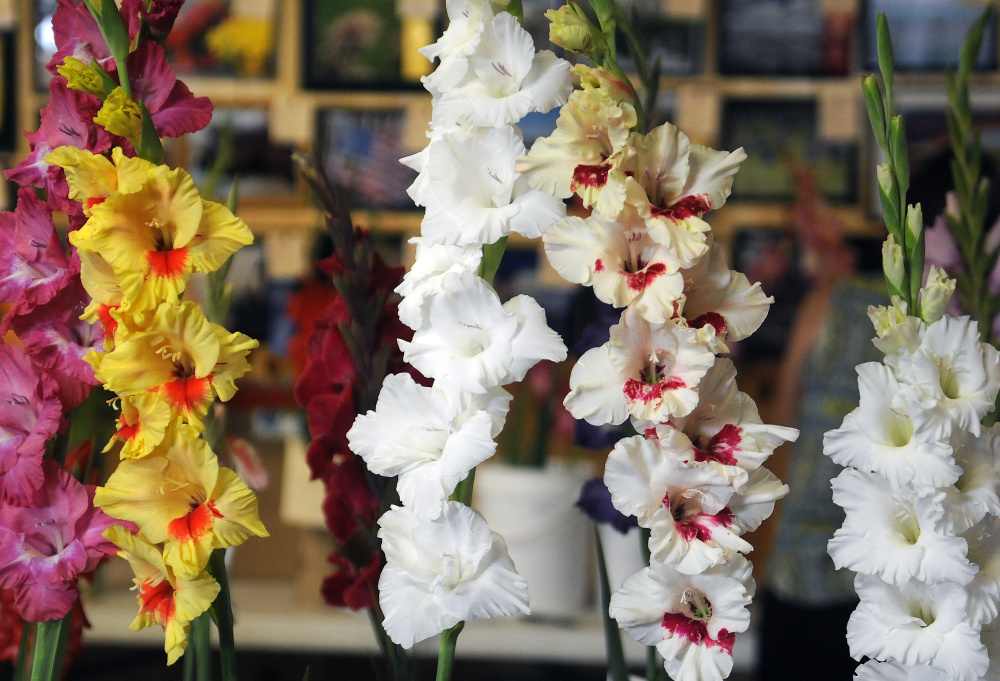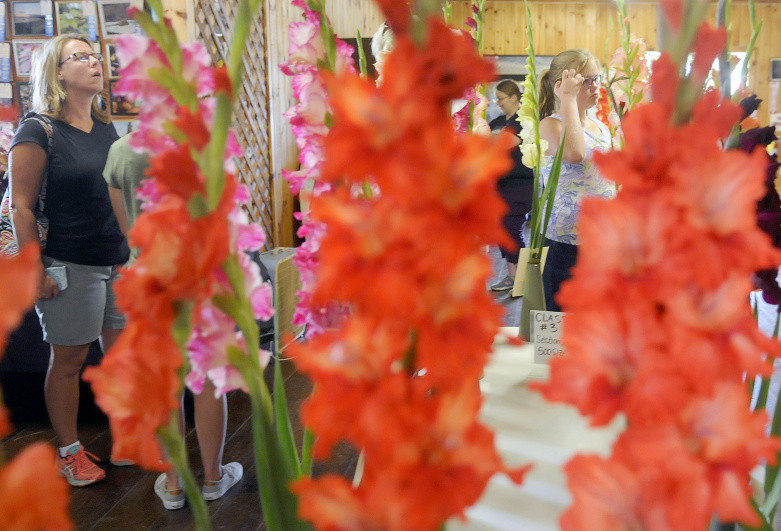WINDSOR — Tall spikes of ruffled and smooth gladiolus in riotous and delicate colors gained the admiration of Joline Frecker of Augusta, who couldn’t resist softly touching a flower because of its velvety-looking texture.
The large round table held the “People’s Choice,” where Windsor Fair attendees could select and then vote for their favorite among the numbered but otherwise unidentified varieties of gladiolus.
Along the Exhibition Hall walls and down the center aisle, more gladiolus bloomed, some as single spikes, others as identical trios, still others fashioned into baskets or serving as centerpieces for holiday-themed arrangements.
The Gladiolus Show and competition Sunday afternoon was one of the many features of the opening day of the Windsor Fair, which runs daily through Labor Day, Sept. 5.
Thomas Foster, president of the fair’s executive committee, said he’s hoping for another banner year like last year, where he estimated 100,000 people attended.
“I hope it’s even more,” he said. “We have lots of harness racing and entertainment daily.”
He also noted that fireworks will be Wednesday this year, immediately following the performance by Yellow Brick Road, the Elton John Tribute Band. New to the fair this year is a moose-calling contest set for 5-6:30 p.m. Friday.
In the Route 32 Road House next door to the gladiolus show, floral arrangers from Augusta Florist spent two 90-minute sessions on Sunday showing fairgoers how they too could produce arrangements with repurposed items from their house and garage and with flowers from their home garden.
Back at the annual Gladiolus Show sponsored by the Maine Gladiolus Society, Frecker said she and Dawn Charest, also of Augusta, vote for a favorite gladiolus every year. Charest was enamored with the smaller, purple ones and trying to choose among them.
“I have some in my garden out front,” Frecker said. “They haven’t done well this year.”
The bulk of the spikes on exhibit came from Cates Family Glads in East Vassalboro, a commercial grower that also produces other flowers along with 150,000 gladiolus annually.
“It’s a dying art,” said Paul Cates, 91, the family patriarch, “but we try to keep going.”
He got his start through an uncle who was a florist in the ’20s and ’30s. “I raised my first glads when I was 10,” he said, pointing out the rose-colored gladiolus that was his mother’s favorite.
In the early 1960s, while working in Germany where he had a gladiolus farm that backed up against the Berlin Wall, he met the woman who later became his wife, Elisabeth Cates. She grew up in what was then East Germany and already had a love of gladiolus.
“In East Germany we had sandy soil and we didn’t have flowers like these here,” she said on Sunday as she reached into a tall container to select another spike to display.
Their daughter, Margaret Flood of Searsmont, who was running the show, talked about individual spikes, including the ruffled-edge, rose and cream-colored Happiness, introduced in 1961.
“The ruffling here is nice to see. It’s something you don’t see in older glads,” she said.
Then she looked down the line at the array of blooms. “The colors have gotten way more bold and flashy in the last few years,” she said, a result of more imported varieties, such as the speckled Rigel exotic.
She said glads are great for people “who like things as ostentatious as a flower could get.”
The bulbs are planted in the spring in a well-drained area as soon as the soil warms. Keeping the spikes tall and straight requires hilling, similar to that done for potato plants. Otherwise, Flood said, “They’re pretty low maintenance.”
Her father takes special precautions with the bulbs that are removed from the ground in the fall, dipping them in a Lysol bath, drying them and storing them carefully in a well ventilated area.
“There’s a stereotype about gladiolus that they’re funeral flowers,” she said. But she’s found that they’re great for showy wedding bouquets where florists use pieces of glads in arrangements including cascades.
Glads grow well in Maine. “We don’t get a lot of diseases they get down South,” Flood said. “We have to pull our bulbs and be nice to them.”
While Flood described how to grow gladiolus, Lisa Gerakaris of Tenants Harbor finished arranging one of her holiday-themed entries. She used a nail and wood in her Easter arrangement, and gladiolus and other flowers and grasses coming out of a skull for the “Brainstorm” holiday display. She has to arrange her displays carefully since she grows only about 40 gladiolus bulbs.
“I just have a garden at my house,” she said. “I grow everything from seed.” She calls herself an “urban agriculturalist.”
Audrey Pottle of Benton brought her gladiolus as well. She grows eight 50-foot rows of them, selling some at her roadside stand.
Arthur Mosher, whose family raises about 10,000 bulbs on their farm on the Liberty/Palermo line, said the fairy glads are the smallest, where a blossom is almost as small as a dime. Others grow much larger. “I’ve had them up to 500 across,” Mosher said, using glad-speak for flowers that can be 5 inches in diameter. Some of the spikes reach to 6 feet.
His daughter-in-law, Vicky Mosher, had done the arrangements for the holiday exhibit. “We have from 9 to noon to arrange and do our creations,” she said.
At noon, Barbara Frye, owner of Chapel Hill Floral in Bangor, judged the gladiolus and the winners moved to the “Court of Honor.”
This year, Cates’ “Prairie Chicken” took grand champion and “Angel Wing” reserve champion.
Arthur Mosher took the grand champion 3-spike with “White Prosperity” and reserve champion with “Chit Chat.”
By 5 p.m., they all would be gone, whisked away so another exhibit could come in.
Betty Adams — 621-5631
Twitter: @betadams
Send questions/comments to the editors.







Success. Please wait for the page to reload. If the page does not reload within 5 seconds, please refresh the page.
Enter your email and password to access comments.
Hi, to comment on stories you must . This profile is in addition to your subscription and website login.
Already have a commenting profile? .
Invalid username/password.
Please check your email to confirm and complete your registration.
Only subscribers are eligible to post comments. Please subscribe or login first for digital access. Here’s why.
Use the form below to reset your password. When you've submitted your account email, we will send an email with a reset code.